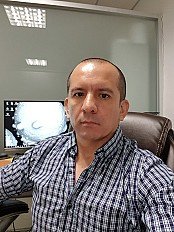
Dr. MARCO AURELIO GONZÁLEZ ALBARRÁN
Resumen curricular:
Dr. Marco Aurelio González Albarrán Estudié la Ingeniería en Materiales en el Instituto Tecnológico de Morelia, Posteriormente la Maestría en Metalurgia en el Centro de Investigación y de Estudios Avanzados del IPN (CINVESTAV) y finalmente, el Doctorado en Ingeniería de Materiales en la Facultad de Ingeniería Mecánica Eléctrica de la Universidad Autónoma de Nuevo León. De agosto de 2004 a Junio 2014, en mi carácter de Consultor Senior trabaje en el Departamento de Análisis de fallas del centro CONACyT; Corporación Mexicana de Investigación en Materiales S.A. de C.V.(COMIMSA). Durante este periodo tuve la oportunidad de especializarme en el tema de metalurgia física de superaleaciones base níquel principalmente, así como también, en aceros al carbono e inoxidables y en menor medida pero no menos importante de algunas aleaciones no ferrosas. Participé de manera amplia en la realización al menos 230 estudios de análisis de falla y más de 50 de análisis de defectos, los cuales tenían como principal objetivo dar recomendaciones necesarias para eliminar y/o mitigar la problemática. Estudios directamente relacionados con industrias; Petrolera, Automotriz, Energía, Química, etc. De septiembre de 2014 a la fecha, me desempeño como investigador del posgrado en ciencia de materiales en el Centro Universitario de Ciencias Exactas e Ingenierías de la Universidad de Guadalajara, dentro del marco de Investigadoras e Investigadores por México, CONACyT. Desarrollado proyectos de investigación relacionados con tribología en específico estudiando la resistencia al desgaste erosivo, abrasivo y por fricción, de recubrimientos aplicados mediante procesos de proyección térmica (APS, HVOF, TWAS). Recientemente estudiando recubrimientos resistentes a la oxidación a temperatura elevada empleados en la industria aeronáutica y generación de energía, así como en recubrimientos aplicados en implantes ortopédicos. Varios de estos proyectos se han desarrollado en conjunto con la empresa Surface Engineering S.A. de C.V. (SURESA). A la que a la par, se le ha brindado asesoría técnica para la realización de proyectos internos y/o mejoras de calidad de producto. Otras empresas a las que se les ha brindado asesoría, o algún servicio de estudio técnico o impartición de cursos son ZF, CUPRUM Y Envases Universales. Así mismo, impartiendo clases en los posgrados de maestría y/o doctorado en ciencia de materiales y recientemente en la Licenciatura en Materiales. Miembro de la Red de Ingeniería de Superficies y Tribología.
Enlaces
Perfil de Investigador SNII:
Bases de datos bibliográficas:
Publicaciones del académico:
- Evaluation of the long-term adhesion properties of thermal barrier coatings reinforced with SiC-ZrB2 particles under thermal cycling conditions
- Enhanced Fracture Toughness of WC-CoCr Thermally Sprayed Coatings by the Addition of NiCrFeSiBC and Mo and Its Influence on Sliding Wear Behavior
- Exploring powder metallurgy-processed Ti–25Ta-xCu alloys for potential biomedical applications
- Enhanced Adherence, Brittleness, Corrosion, and Sliding Wear by Adding NiCrFeBSiC-Mo on WC-Co Coatings and Hardened Substrates
- Exploring powder metallurgy-processed Ti–25Ta-xCu alloys for potential biomedical applications
- Elastoplastic and Electrochemical Characterization of xTiB2 Strengthened Ti Porous Composites for Their Potential Biomedical Applications
- Study of the Incorporation of SiC Microfibers and Their Effect on Adherence at the Interface of a NiCoCrAlY-7YSZ Thermal Barrier Coating
- High-Temperature Erosion of SiC-NiCrAlY/Cr3C2-NiCr Coating
- Microstructure and Mechanical Properties of Ti-TiH2 Based Matrix Composites Reinforced with xTiB2 Particles Processed by Powder Metallurgy
- 生物医用 Ti6Al4V/xTiN 复合材料的腐蚀与腐蚀磨损行为 (英文)
- 生物医用 Ti6Al4V/xTiN 复合材料的腐蚀与腐蚀磨损行为 (英文)
- 生物医用 Ti6Al4V/xTiN 复合材料的腐蚀与腐蚀磨损行为 (英文)
- 生物医用 Ti6Al4V/xTiN 复合材料的腐蚀与腐蚀磨损行为 (英文)
- 生物医用 Ti6Al4V/xTiN 复合材料的腐蚀与腐蚀磨损行为 (英文)
- 生物医用 Ti6Al4V/xTiN 复合材料的腐蚀与腐蚀磨损行为 (英文)
- 生物医用 Ti6Al4V/xTiN 复合材料的腐蚀与腐蚀磨损行为 (英文)
- 生物医用 Ti6Al4V/xTiN 复合材料的腐蚀与腐蚀磨损行为 (英文)
- 生物医用 Ti6Al4V/xTiN 复合材料的腐蚀与腐蚀磨损行为 (英文)
- Corrosion and tribocorrosion behavior of Ti6Al4V/xTiN composites for biomedical applications
- 生物医用 Ti6Al4V/xTiN 复合材料的腐蚀与腐蚀磨损行为 (英文)
- 生物医用 Ti6Al4V/xTiN 复合材料的腐蚀与腐蚀磨损行为 (英文)
- Microstructural and high-temperature cyclic oxidation response of NiCoCrAlY coatings with and without SiC + ZrB2 reactive-element dispenser
- Nanoindentation and tribological properties of Ni51Ti49−xTax (x < 5 at. %) alloys fabricated by arc melting
- Nanoindentation and tribological properties of Ni51Ti49− xTax (x< 5 at.%) alloys fabricated by arc melting
- Nanoindentation and tribological properties of Ni51Ti49− xTax (x< 5 at.%) alloys fabricated by arc melting
- Microstructural and high-temperature cyclic oxidation response of NiCoCrAlY coatings with and without SiC+ ZrB2 reactive-element dispenser
- Nanoindentation and tribological properties of Ni51Ti49− xTax (x< 5 at.%) alloys fabricated by arc melting
- Enhanced adhesion resistance of an 8YSZ thermal barrier coating trough the formation of zircon and mullite as self-healing reaction products under cyclic oxidation conditions
- Erosion behavior of 440C stainless steel cryogenically treated
- Erosion behavior of 440C stainless steel cryogenically treated Comportamiento bajo la erosión del acero inoxidable 440C tratado criogénicamente
- Tribocorrosion behavior of Spark Plasma Sintering TiC reinforced Ti-based composites
- Effect of SiC microfibers as a self-healing agent and their influence on oxidation and adhesion resistance of thermal barrier coatings exposed to cyclic thermal oxidation treatments
- Erosion problem in tool steel using cold box core-making process
- Effect of SiC microfibers as a self-healing agent and their influence on oxidation and adhesion resistance of thermal barrier coatings exposed to cyclic thermal oxidation …
- Effect of SiC microfibers as a self-healing agent and their influence on oxidation and adhesion resistance of thermal barrier coatings exposed to cyclic thermal oxidation …
- Study of the preparation of TiO2 powder by different synthesis methods
- Gas Sensing Properties of NiSb2O6 Micro-and Nanoparticles in Propane and Carbon Monoxide Atmospheres
- Heat treated twin wire arc spray AISI 420 coatings under dry and wet abrasive wear
- Gas sensing properties of NiSb2O6 micro-and nanoparticles in propane and carbon monoxide atmospheres
- Study of the erosive wear behaviour of cryogenically and tempered WC-CoCr coating deposited by HVOF
- Effect of torch weaving on the microstructure, tensile and impact resistances, and fracture of the HAZ and weld bead by robotic GMAW process on ASTM A36 steel
- Aging thermal treatment in the Inconel 725 brazed incorporating tungsten nanoparticles
- Effects of pulse length on low frequency plasma nitrided 316L steels
- Influences of Processing Time and Discharge Current Density During Pulsed Plasma-Oxidizing process of AISI 316L


